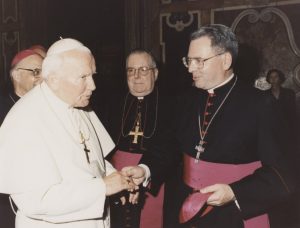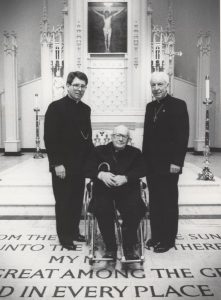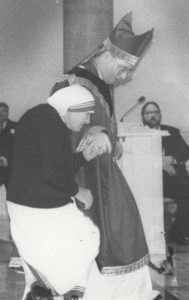Native son Bishop Myers guided the Diocese of Peoria into new millennium

Bishop Myers greets the crowd after a liturgy at St. Mary's Cathedral in Peoria in this Catholic Post file photo.
Archbishop John J. Myers, the seventh bishop of Peoria and the second native son in a row to hold that office, guided the Diocese of Peoria from 1990 until his appointment as Archbishop of Newark in 2001. His 11 years as diocesan bishop saw a surge in priestly vocations, preparations for Jubilee Year 2000, establishment of a new Catholic high school, and many other projects to prepare for a new millennium.
It was announced on Nov. 7 that Pope Francis accepted his resignation as archbishop of Newark. Archbishop Myers, 75, will observe the 50th anniversary of his ordination as a priest of the Diocese of Peoria on Dec. 17.
Born July 26, 1941, in Ottawa to M.W. “Jack and Margaret (Donahue) Myers, he was the first of the couple’s seven children and was raised on a farm near Earlville in LaSalle County. A native of St. Theresa Parish in Earlville, he attended St. Bede Academy but later returned to Earlville High School, graduating in 1959 at the top of his class.

Bishop Myers visits with St. John Paul II during an ad limina visit to the Vatican representing the Diocese of Peoria in 1997. (Photo by Felici)
The future bishop was not convinced of his vocation to the priesthood until the end of his freshman year at Loras College in Dubuque, Iowa. “God kept asking me” to be a priest, he told Emmaus Days retreatants in 1995, but I didn’t pay a lot of attention at first.”
He switched to the college’s seminary program in his sophomore year, graduated in 1963 and completed studies for the priesthood at North American College in Rome.
Ordained on Dec. 17, 1966, in Rome, his first assignment was as an assistant at Holy Family Parish in Peoria. He then worked in the international affairs office of the U.S. Catholic Conference before returning to the diocese in 1971 to serve as an assistant at St. Matthew’s Parish in Champaign.
In 1974 he began studies for a doctorate in canon law at The Catholic University of America. After earning his J.C.D. degree in 1977, Father Myers was appointed vice chancellor and vocations director by Bishop Edward W. O’Rourke. He served as vocations director – launching the highly popular Emmaus Days vocation awareness retreats for young men — and later as chancellor until his appointment as coadjutor bishop of Peoria in 1987.
For two and a half years after his episcopal ordination on Sept. 3, 1987, Bishop Myers assisted Bishop O’Rourke with various duties. When Bishop O’Rourke announced his retirement on Jan. 23, 1990, Bishop Myers was his automatic successor.

Bishop Myers is pictured in the sanctuary of St. Mary’s Cathedral in Peoria with Bishop Edward W. O’Rourke, right, on the occasion of the 91st birthday of their predecessor, Bishop John B. Franz, in this 1987 Catholic Post file photo.
Five months later Bishop Myers released his first and most highly publicized pastoral message, “The Obligations of Catholics and the Rights of Unborn Children.” The pastoral drew national attention for stating that “there is, and can be, no such thing as an authentic ‘pro-choice’ Catholic.”
His next pastoral, “The Eucharist: Sacrifice of Love,” announced plans for a Diocesan Eucharistic Congress in 1992, to be preceded by a year of special attention and devotion to the Eucharist.
Later pastorals included “To Reach Full Knowledge of the Truth” (1993) on Catholic education; “A Fresh, Spiritual Way of Thinking” (1995) on chastity education; “Fathers Make Known to Children Your Faithfulness” (1997) on fatherhood; and “A Letter to My Brother Priests” (2001) on opportunities and lifestyles for senior or retired priests.
Bishop Myers ordained more than 80 new diocesan priests during his 11 ½ years as bishop of the Diocese of Peoria. In some years the diocese ordained as many or more priests than far larger sees such as New York, Chicago, or Los Angeles – again gaining national attention for bucking the trend of declining vocations.
He presided over a number of major diocese-wide events, including the 1992 Diocesan Eucharistic Congress, Mother Teresa’s visit to Peoria in 1995, and four Evangelization Congresses as well as a series of regional Masses in preparation for Jubilee Year 2000.

Bishop Myers leads St. Teresa of Kolkata into St. Mary’s Cathedral during her historic visit to Peoria in 1995.
In 1998 he announced the creation of the diocese’s first new Catholic high school in 35 years, The High School of Saint Thomas More in Champaign. It opened in the fall of 2000.
Also in 2000, he announced the creation of the St. John Bosco Catechetical Institute, a program of formation and education for catechists that would eventually include 100-plus hours of instruction for all parish and school catechists.
He invited several new religious communities into the diocese, including Mother Teresa’s Missionaries of Charity, the Community of St. John, the Sisters of St. Francis of the Martyr St. George (Alton Franciscans), the Handmaids of Nazareth, the Rockford Poor Clares, and the Apostles of the Interior Life. In 1994, with then-Bishop Charles Chaput of Rapid City, S.D., Bishop Myers formed a “sister diocese” relationship between the dioceses of Peoria and Rapid City.
Bishop Myers was called to continue his ministry elsewhere on July 24, 2001, when Pope John Paul II appointed him archbishop of Newark to succeed Archbishop Theodore McCarrick. He was installed as the fifth Archbishop of Newark on Oct. 9, 2001 — just one month after the terrorist attacks of Sept. 11, 2001.





